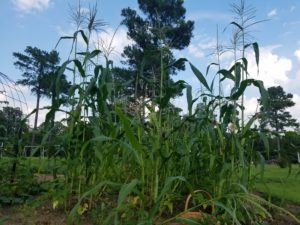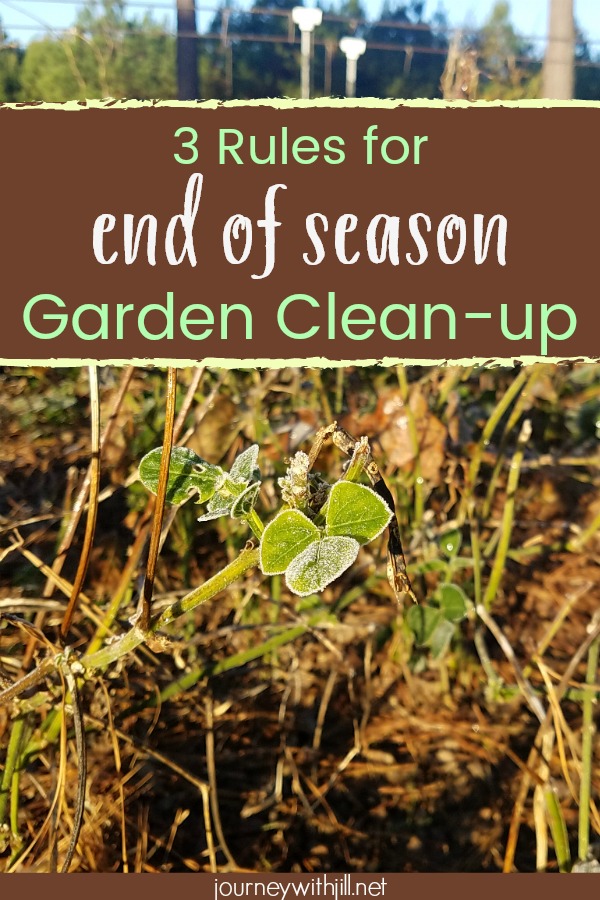End of Season Garden Clean-up Ideas
Even if you have a few plants remaining in the soil for a fall harvest, your spent summer crops require garden clean-up. Sometimes this task can prove a burden after a long and tiring season. Other times the thought of a clean slate gives you a burst of energy to prepare the garden space for next year.
For the first couple of years of my garden, I simply cleared my land with no thought of how I would prepare the soil for the next season. But I learned the current year’s spent crops can add nutrients and beneficial soil structure. In a long-season garden like mine, where many times three crops will hold the same garden space with succession planting, replenishing those nutrients must take top priority.
But where do you start?
In this episode of the Beginner’s Garden Podcast, I go over general guidelines and specific tips on how to clean up your garden after the summer crops are finished.
Click below to listen or read on for the basics.
How to Tackle End of Season Garden Clean-Up
When you start to pull out your summer crops, you need to keep three main guidelines in mind: throw out your diseased plants, aim for no bare land, and replenish the soil.
Throw out your diseased plants
Plant diseases persist in the soil, so you do not want to compost any plants affected by them. In my garden this means most of my tomato plants will not go in the compost or stay in the garden because early blight is always an issue. Other diseases that persist in the soil are more devastating to future crops, such as certain wilts. You also want to throw out squash plants that have been affected with mildew.
No bare land
This may seem contradictory since we’re talking about garden clean-up, but you do not want your garden to sit bare all winter. Erosion from rain and from the freezing and thawing cycle will strip the topsoil from your garden. Nutrient-rich topsoil is your plants’ primary food source.
Replenish the Soil
Since your crops have taken up many of the nutrients from that topsoil, you need to begin nourishing it again. Keeping in mind that you don’t want any bare land, there are several ways you can replenish the nutrients in the soil to prepare next season’s garden with ample fertility.

How to Replenish Spent Garden Soil
Thankfully, adding nutrients to your garden soil isn’t as hard as you think, you have many options available to you, depending on what resources you have at your disposal.
Cover in compost
Hopefully, you’ve been adding your kitchen scraps, rotten garden waste, and other ingredients to your compost pile all summer. By the end of the season, my bin is usually filled to the brim. Cover your garden or raised bed with this compost. It’s okay if it’s not broken down all the way into the black-gold-tilth; it will continue breaking down and nourishing your garden over the winter. It will also feed the earthworms, which make nutrient-rich earthworm castings (worm poop) for the soil.
Cover in manure
If you have access to poultry or livestock manure, fall is the perfect time to cover your garden with it. Manure is full of nitrogen, but because the nitrogen content is so high, applying it in the growing season will burn plants. But, if you apply it in the fall, it has time to break down and stabilize, just in time for your spring planting.
Plant cover crops
Whether your garden is small or large, you can utilize cover crops to add nutrition to your soil. Plantings of ryegrass, winter rye, hairy vetch, buckwheat, and others keep the soil covered, (preventing erosion), photosynthesize sunlight, keep beneficial fungal networks in place, and tap into minerals deeper in the soil. When cut down, winter-killed, or tilled, these crops incorporate all of those naturally-manufactured nutrients back into the soil.
Cover in mulch
If you lack access to compost or manure, and if you’re not ready to delve into planting cover crops, at the very least cover your garden in mulch. This serves two purposes. One, it keeps the soil in place, preventing the erosion of remaining nutrients and protecting soil structure. Second, as the mulch begins breaking down over the winter, it provides nutrients to the soil itself. I keep mine covered in wood chips I use as mulch all season, but there are other options as well. If you have access to fallen leaves, you can collect them and add them to your garden.
How to Replenish Container Soil
If you planted your garden in containers, you can reuse the container soil as long as you had no disease problems. But, you will need to add half to two-thirds of new soil next season to replenish those nutrients. Before removing the soil for the winter, clean the containers with soap and water, and store them in a sheltered area.
Here is a video that explains this more in-depth:
What to Do with Specific Crops
Now that you have the general guidelines, here are some ideas on how to clear specific crops from the garden in order to nourish next year’s garden most effectively:
Beans & Peas
Beans and peas actually convert nitrogen in the air to a usable source in the soil, and much of that nitrogen content is found in the roots. Therefore, instead of pulling beans and peas out, root and all, snip each plant at the soil level and leave that valuable nitrogen in the soil. When you’re planning next season’s garden, make the best use of that nitrogen by planting nitrogen-heavy feeders like corn or squash.
As for the plants themselves, they are also a rich source of nutrients. You can either add them to your compost or “chop and drop” them and leave them on the soil. When adding to your compost, I recommend chopping them into finer pieces to allow them to break down more efficiently.

Corn
Corn plants produce a lot of biomass, and you’ll want to put this to use for next season’s garden. After corn stalks dry up, they are an ideal mulch, so you can “chop and drop” them in place, or like beans, add the chopped matter to the compost pile.
Because corn is such a heavy nitrogen feeder, I recommend planting a cover crop in that place to help replenish the nitrogen for the next year’s crop.
Squash and Zucchini
If you’ve had a heavy infestation of pests, such as squash bugs or the squash vine borer, I recommend throwing the whole plant out. You don’t want these bugs overwintering in your compost in case it doesn’t get hot enough to kill them.
If you have chickens, give the plants to them — they’ll take care of all the insects. I can’t be certain, but I believe this practice year after year has helped my squash bug population decline dramatically.
Also, if you have any problems with disease, as mentioned above, throw out the plant and do not compost.
But, if your plants are large and healthy, you can “chop and drop” or chop them up and throw them in the compost pile.
Okra
When I was a little girl, my mom grew incredible okra. When she went to pull them out at the end of the season, she slipped a disc in her neck that required surgery. Pulling out okra isn’t easy, and I know of one person who uses his four-wheeler to pry his stalks out at the end of the season. If you don’t want to go through the trouble, leave the stalks in the ground over the winter. They will not only come out with a gentle tug in the spring, but they’ll also provide a haven for beneficial insects over the winter — insects you want making their homes in the garden.
Here is a look at how I clear many of these crops:
VIDEO: Spent Crops: What to do with them to prepare for next season
To Till or Not to Till?
I am a believer that our gardens will grow toward greater overall health when we do not disturb the soil. Therefore, I have never tilled my fall garden and only tilled my spring garden the first few seasons.
That said, I think there are certain circumstances where tilling might be beneficial. If your garden was taken over by weeds and grasses, or if you’ve had an outbreak of pests, tilling might be a good option. By tilling a pest-infested area, you’re giving birds and other predators access to decrease this population. But again, I’d only use this in extreme circumstances.
If you have chickens, let them free range in your garden over the winter. When I do this, they aerate the soil at the top levels without disturbing the lower ground. They also eat the bugs and fertilize the ground all winter with their manure. Yes, predators like hawks are a risk, but when I left my okra in the ground as well as a row of my spent bean plants, they sheltered under these plants for protection. I know this may have been luck, but it worked out for us.
What practices have you found beneficial for garden clean-up?
Do you get overwhelmed with garden planning?

Subscribe here for my best tips to plan your garden in just 7 days -- all for FREE.
Plus, I'll send you my "In the Garden E-mail" on Fridays, periodic updates on garden resources relevant to you, and you'll receive access to my entire bank of free garden downloads!
You are also agreeing to our privacy policy.


Hi Jill! Wondering if you can help me. My newly opened garden, after about 5 yrs sitting unused and covered, is invested with weeds from those neglected years. I weeded and cleaned it out in the spring, but the weeds came back and went beyond my control. I think the soil was depleted of nutrients, too. Next summer I’m traveling quite a bit, so I’m wondering if you have any suggestions as to what I should do with my garden this fall, winter and next season so it’s not unused or neglected again, but yet not needing my constant management since I’ll be traveling? I don’t want to till and disturb the soil to get those weeds, just feed it – this season’s plants were puny and didn’t do well (I think from all the weeds and the weak soil from years of being covered). I do have compost, and practice organic gardening, but as a novice gardener, I definitely failed this season :). Any suggestions and advice would be greatly appreciated!
Hi Shelley, you have a couple of options. One is to cover it significantly using a No Dig Gardening approach. (More on this here: https://journeywithjill.net/gardening/2021/05/25/why-and-how-to-grow-a-garden-without-tilling/ ) Another option is to cover the whole area (now) with black tarp to kill off the vegetation while it’s still hot. I haven’t done the latter myself but I hear a lot about it. For me, it just took covering with wood chip mulch (a thick layer) year after year before the weeds became less of a problem.
Hi Jill,
I still have annuals/perennials that are still green in the pots. Should i start cleaning it up and throwing them in the compost? Or do i wait till they turn brown? Some of it are still doing well and i hate to yank it out yet. c”)
Perennials you will want to leave all winter. A layer of mulch can be good, but not always necessary. For annuals, I guess that depends on whether you want to go ahead and get them out or not. I usually let mine stay until the frost/freeze kills them.